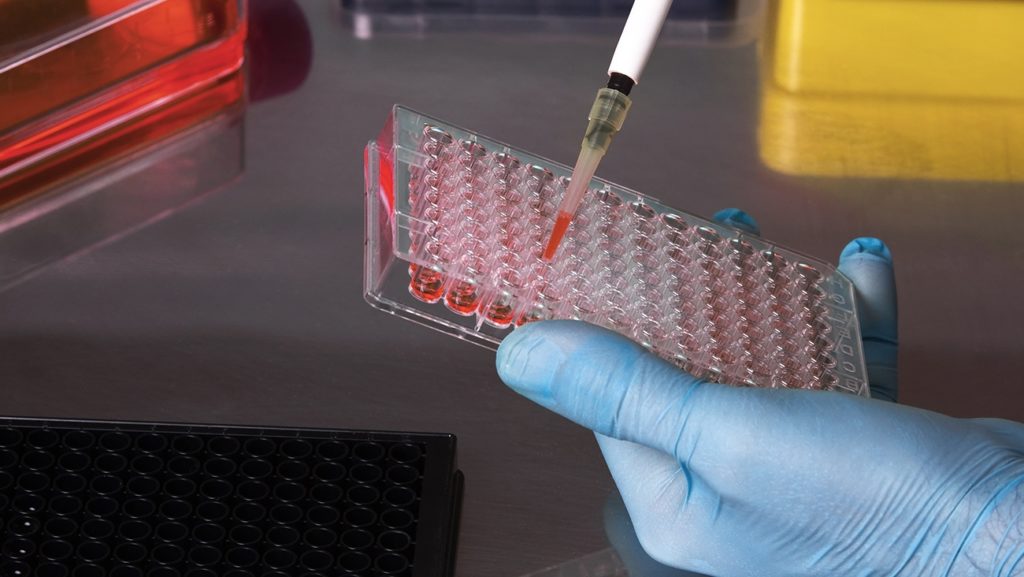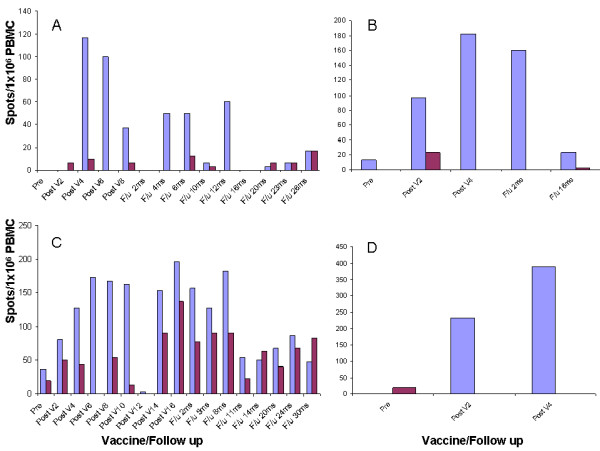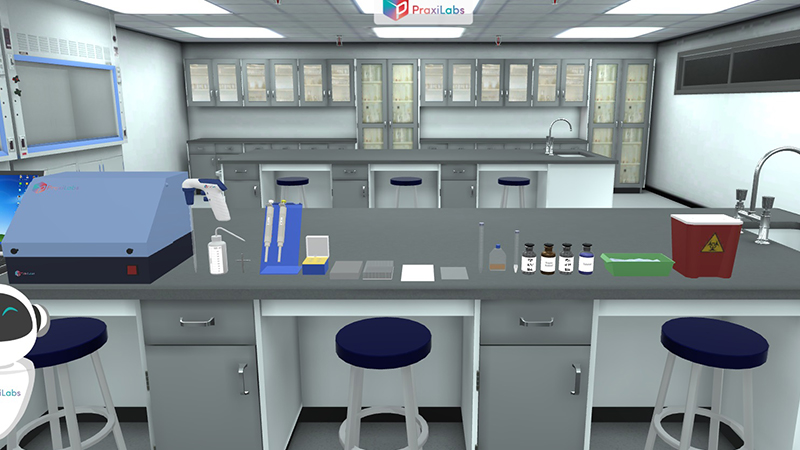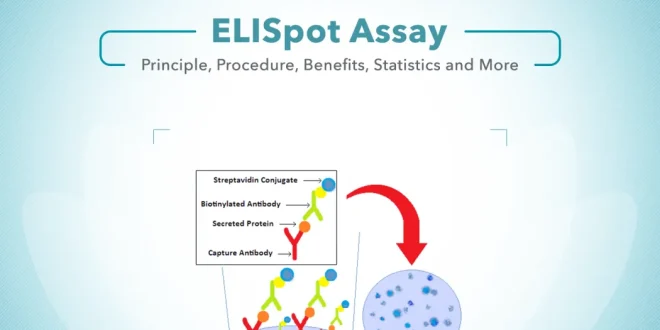Last Updated on August 22, 2025 by Muhamed Elmesery
ELISpot assay stands for the enzyme-linked immunospot assay. It is a very sensitive method used for measuring the number of cytokines secreting cells. And then measuring the antigen-specific T cells.
In this article we will disscus ElISpot principle, steps, benifits, protocol, applications and more.
Get started Praxilabs for FREE
Table of Contents
ELISpot Assay for T Cell Responses
ELISpot assay was developed for the quantification of cells that secrete proteins, such as cytokines and growth factors (ex: to estimate the frequency of specific B-lymphocytes). Now it is widely used as the technique of measuring T cell responses allowing the quantification of specific-cytokine secreting cells at the single-cell level.
ELISpot Assay Principle
ELIspot assay is conducted using a PVDF (or nitrocellulose) membrane 96-well plate, which is pre-coated with a specific capture antibody to the secreted protein. The cells are added to the plate and then they are stimulated for secreting their proteins. The secreted protein binds to the coating antibody. A specific antibody is added which is specific to the bound protein.
After the incubation, the added cells are removed and the secreted proein molecule is detected by a determintion antibody complex in a similar procedure to that employed by the ELISA.
Detecting the antibody complex can be done either enzymatically (the antibody is directly conjugated to an enzyme and produces a colored substrate) or fluorescently, which can detect one secreted protein or more at a time.
In the end, each secreting cell appears as a visible spot of color or fluorescence which allows the process of quantitative evaluation of cells secreting proteins. The membrane can be analyzed either by an automated reader or by manually counting the spots. Each spot refers to an individual cytokine-secreting cell.

The previous image shows ELISpot Assay kit.
Benefits of ELISpot Assay
ELISpot Assay is commonly used in immunology research.
ELISpot assay is used in:
Vaccine development (IFNγ)\Viral infection monitoring and treatment\Transplantation\Analyzing dendritic cells and monocytes\Th1/Th2, T cell regulation.
On of the vital benefits of ELISpot is that can be used to study cancer, allergies, and autoimmune diseases.
One of the most important reasons for the popularity of this method is that ELISpot assay is highly quantitative, as it can measure a wide range of magnitudes of response and it can assess important cellular immune-related activities such as granzyme B release and IFN-γ secretion.
ELIspot is also highly adaptable not only to evaluate a variety of T-cell functions but also to innate immune cells and B cells.
ELISpot has evolved from a research tool to an important clinical assay. Recent studies of cancer vaccines tested in a variety of malignancies have suggested that ELIspot may be a useful biomarker to predict clinical benefit after therapeutic immune modulation.
ELISpot assay for t cell responses measuring as we mentioned before.
ELISpot Assay Protocol
As we mentioned before ELIspot assay is conducted using a PVDF (or nitrocellulose) membrane 96-well plate, which is pre-coated with a specific capture antibody to the secreted protein. The cells are added to the plate and then they are stimulated for secreting their proteins. The secreted protein binds to the coating antibody. A specific antibody is added which is specific to the bound protein.
The membrane is analyzed by counting the spots or an automated reader designed for this purpose. Each secreting cell appears as fluorescence or a spot of color, and this is a quantitative method for evaluating protein secretion.
The following infographic describes ELISpot assay protocol and procedure:
ELISpot assay method variations (Flurospot Assay)
The Fluorospot Assay is considered a variation or an advancement of the ELIspot assay, it uses the fluorescence to analyze multiple analytes, meaning it can enable simultaneous measurement of different analytes secreted at a single-cell level, allowing parallel detection of several cytokines secreted by immune cells upon antigen recognition.
ELISpot Analysis
Analysis is the last step in ELIspot procedure. The forming spots can be quantified from the number of spots in the well and the cell input. The spots are counted under a microscope or by an automated reader, and finally we can calculate the frequency of the secreting cells from forming cells.
In theELISpot Analysis software, the following parameters are used for measurement:
- Size/spot diameter.
- Circularity/shape.
- Intensity/saturation.
- Spot development/slope.
PraxiLabs virtual science labs enable you to conduct various laboratory experiments in physics, chemistry, and biology online anytime and anywhere. Create your free account and try the virtual labs that explain all about sulfite ion.
ELISpot assay statistics

Immune responses measured by ELISPOT assay. ELISPOT results for all patients who had positive immune responses to the corresponding VHL peptide (spots/106 PBMC) in purple compared with the control peptide (TAX) in red: patient 2 (panel A); patient 6 (panel C); patient 3 (panel B); and patient 4 (panel D). Pre = prevaccination sample; Post V = postvaccination sample marked by the vaccine number; and F/u = follow up sample marked in months (ms) from the last post-vaccine sample.
ELISpot Assay COVID
ELIspot Assays are used now for Coronavirus Research, It (The antigen-down B cell) is a powerful 96-well method to study the immune response extent to viral infections.
The larger the number of spots formed by B cells, the stronger the antibody-producing capacity of the immune system. The B cell ELISpot is built with specific and sensitive antibodies. When they paired with SARS-CoV-2 proteins, it becomes sensitive and specific serological assay for SARS-CoV-2 infection.
ELISpot Assay vs ELISA
ELISA or the Enzyme-Linked Immunosorbent Assay is considered a common laboratory technique that is used to measure the concentration of antibodies or antigens) in solutions. It is a widely used technique in virology and microbiology, for investigating infectious pathogens.
ELIspot assay is considered an adaptation of a sandwich ELISA (In principle).
What is the difference between ELISA and ELISpot?
The major difference between ELISA and ELISpot is that an ELISpot is a combination of both a bioassay and immunoassay, as the cells are cultured in the wells of the ELISpot plate directly.
An ELISA detects the total concentration of the secreted signaling antibody (or protein), whereas an ELISPOT assay determines the individual cytokine or antibody-secreting cells.
So, ELIspot assays should be used in addition to ELISA not instead of ELISA.
The ELIspot assay can be 100: 400 times more sensitive than the conventional ELISA, as the secreted protein is captured onto the well of an ELISpot plate directly before it will be diluted in the culture supernatant, captured by receptors on adjacent cells, or degraded by proteases.
Common Questions and Answers about ELISpot Assay
Is ELISpot a type of ELISA?
Yes, as we mentioned before, ELISpot assay is considered an adaptation of a sandwich ELISA (In principle).
In which area of research should an ELISpot assay be used?
The ELISPOT assay is widely used in different fields of biomedical research including:
- Infectious and autoimmune diseases.
- Organ transplantation.
- Cancer Research.
- Vaccine development.
- Allergy.
Are ELISpot substrates soluble?
No, ELISpot substrates make precipitating products, so they are not soluble.
Note: ELISA substrates make soluble products.
What is Indirect ELIspot?
Indirect ELIspot refers to the case that the cells take some time to respond to the stimulation and may require pretreatment with the stimulant in a separate 96-well culture dish before the process of transferring to the ELISPOT plate.
What are the applications of ELISpot assay?
- The ELIspot assay is used in many fields and applications like vaccine development, cancer research, characterization of macrophages, monocytes and dendritic cells, apolipoproteins analysis, allergies ( Control of de-sensibilization treatment of allergic diseases) organs transportation (Prediction of rejection crisis ), and veterinary research.
- Diagnosis and analysis of autoimmune diseases like: Multiple Sclerosis and Diabetes is one if the most important applications of elispot assay.
- Detection of the transfection efficiency in gene therapy.
- Measurement of secretory products of tumors, low frequency tissues, and immune cells.
- The measurement of antigen-specific responses post-vaccination in peripheral blood cell preparations.
How do you perform an ELISpot?
The general steps to perform ELISpot assay are:
- Coating the antibody.
- Incubation of the target cell.
- Cytokine capture.
- Antibodies detection.
- Enzyme conjugate.
- Adding the substrate.
- Analysis.
The following video shows How to perform an ELISpot in details.
PraxiLabs provides ELISpot Assay Virtual Lab Simulation that you can access anytime and anywhere to perform it. Subscribe and get started now!

 PraxiLabs A virtual world of science
PraxiLabs A virtual world of science






